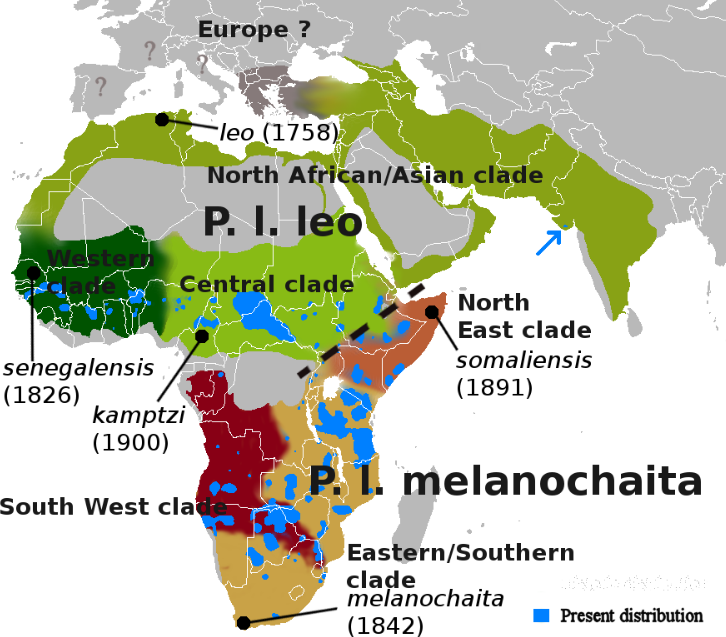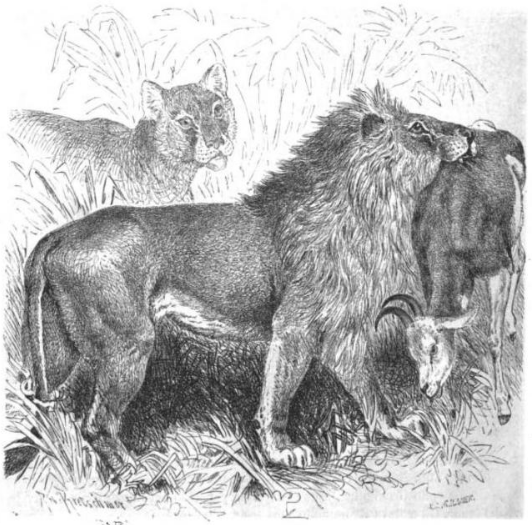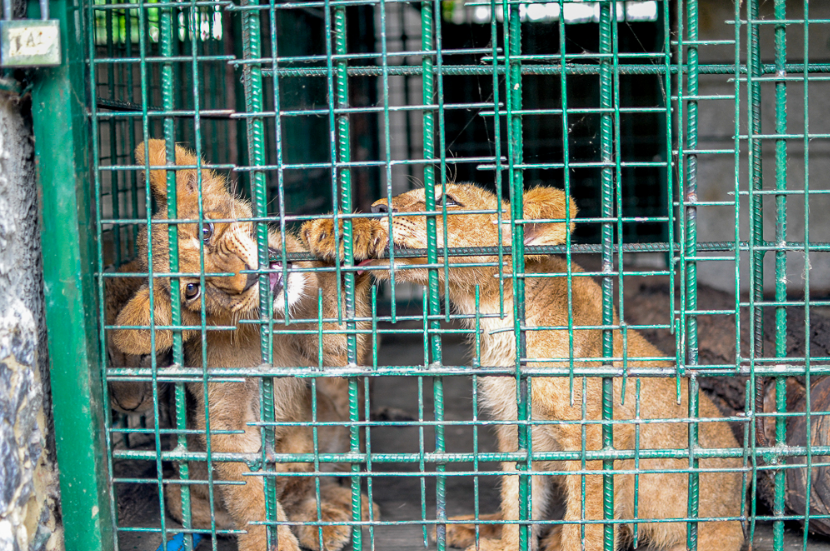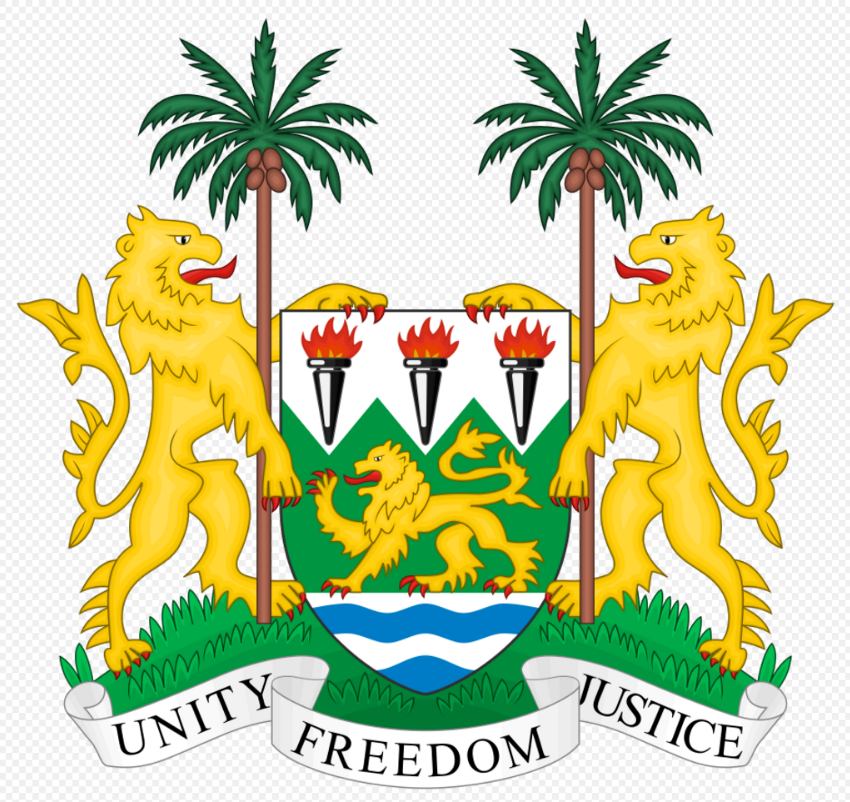
| Version | Summary | Created by | Modification | Content Size | Created at | Operation |
|---|---|---|---|---|---|---|
| 1 | Vivi Li | -- | 1068 | 2022-10-17 01:34:27 |
Video Upload Options
The West African lion is a Panthera leo leo population in West Africa. It is listed as Critically Endangered on the IUCN Red List. This population is isolated and probably comprises fewer than 250 mature individuals. Already in 2004, the lion population in West and Central Africa was fragmented and estimated as comprising at most 1,800 individuals. The West African lion was formerly considered a distinct lion subspecies with the scientific name P. l. senegalensis. Results of phylogenetic research indicate that the West African lion population forms a distinct clade and is closely related to Central African, North African and Asian lion populations. The lion populations in North, West and Central Africa and Asia were therefore subsumed to P. l. leo in 2017.
1. Taxonomic History

In the 19th and early 20th centuries, several lion type specimens from West African countries formed the basis for descriptions of putative subspecies:[1]
The validity of these purported subspecies was discussed until the early 21st century.[1][4][5][6]
Results of phylogeographic research on lion samples contributed to clarifying the taxonomic status of the West African lion. It was subsumed to P. l. leo in 2017 by the Cat Classification Task Force of the IUCN Cat Specialist Group:[7]
1.1. Phylogeographic Research
In a comprehensive study about the evolution of lions, 357 samples of 11 lion populations were examined, including some hybrid lions. The hybrids had descended from lions captured in Angola and Zimbabwe, and apparently West or Central Africa. Results indicated that four lions from Morocco did not exhibit any unique genetic characteristics and shared mitochondrial haplotypes H5 and H6 with lions from West Africa, and together with them were part of a major mtDNA grouping (lineage III) that also included Asiatic samples. This scenario was well in line with theories on lion evolution: lineage III developed in East Africa and traveled north and west in the first wave of lion expansions about 118,000 years ago. It apparently broke up into haplotypes H5 and H6 within Africa, and then into H7 and H8 in West Asia.[8]
Results of genetic analyses indicate that lions in West Africa and northern parts of Central Africa form different lion clades, which are more closely related to North African and Asiatic lions than to lions in Southern Africa and southern parts of East Africa. The Eastern border of the West African lion is situated in Nigeria and follows the lower Niger river.[9][10]
2. Characteristics

The West African lion is similar in general appearance and size as lions in other parts of Africa and Asia. Its fur varies in colour from light buff to dark brown. It has rounded ears and a black tail tuft. Average head-to-body length of male lions is 2.47–2.84 m (8.1–9.3 ft) with a weight of 148.2–190.9 kg (327–421 lb). Females are smaller and less heavy.[11][12]
A few lion specimens from West Africa obtained by museums have been described as having shorter manes than lions from other African regions.[1] Male lions with weak manes were observed in Benin's Pendjari National Park[13] and in Senegal.[14]
3. Distribution and Habitat
The West African lion is distributed south of the Sahara from Senegal in the west to Nigeria in the east. The population in West Africa has lost 99% of its former range.[15] It is regionally extinct in Mauritania, Gambia, Guinea-Bissau, Mali, Sierra Leone, Ivory Coast, and Togo, and possibly extinct in Guinea. Surveys carried out between 2006 and 2012 revealed that the West African population declined to a few hundred individuals in fragmented populations between Senegal and Nigeria.[16] In Mauritania, lions used to be present in the 1950s in savanna woodlands in the Néma, northern Tagant, Brakna, Hodh El Gharbi and Trarza Regions, and along the Karakoro and Senegal Rivers. In the country's Guidimaka Region, lions survived until the late 1980s.[17]
In Ghana's Mole National Park, an adult male lion and a female lion were sighted in 2015. These were the first sightings of lions in the country in 39 years.[18]
The largest West African subpopulation of between 246 and 466 individuals survives in the W-Arly-Pendjari Complex, a large system of protected areas formed mainly by W, Arli, and Pendjari National Parks in Burkina Faso, Niger and Benin. The other subpopulations consist of only a few individuals in Niokolo-Koba National Park in Senegal and in two sites in Nigeria, one in Kainji Lake National Park and the other in Yankari Game Reserve. The population at Kainji Lake might be connected to that of the W-Arly-Pendjari Complex.[19] These small subpopulations are probably declining.[15]
Contemporary lion distribution and habitat quality in savannahs of West and Central Africa was assessed in 2005, and Lion Conservation Units (LCU) mapped.[20] Educated guesses for size of populations in these LCUs ranged from 1,213 to 480 individuals between 2002 and 2012.[17][21]
| Range countries | Lion Conservation Units | Area in km2 |
|---|---|---|
| Senegal, Mali, Guinea-Bissau, Guinea | Niokolo-Koba National Park | 90,384[21] |
| Guinea | National Park of Upper Niger | 613[21] |
| Benin, Burkina Faso, Niger | W-Arly-Pendjari Complex | 29,403[21] |
| Benin | three unprotected areas | 6,833[21] |
| Nigeria | Yankari National Park and Kainji National Park | 6,551[21] |
| Total | 133,784 |
4. Behaviour and Ecology
In Benin’s Pendjari National Park, lion groups range from 1–8 individuals. Outside the national park, groups are smaller and more single male lions occur.[22]
5. Threats
The West African lion population is threatened by poaching and illegal trade of body parts. Lion body parts from Benin are smuggled to Niger, Nigeria, Gabon, Ivory Coast, Senegal and Guinea, and from Burkina Faso to Benin, Ivory Coast, Senegal and Guinea.[23]
6. Conservation

In 2006, a Lion Conservation Strategy for West and Central Africa was developed in cooperation between IUCN regional offices and wildlife conservation organisations. The strategy envisages to maintain sufficient habita and a sufficient wild prey base, reduce factors that lead to further fragmentation of populations and make lion-human coexistence sustainable.[20]
6.1. In Captivity
In 2006, there were 13 captive lions registered under the name P. l. senegalensis.[24]
7. Cultural Significance

The title "Lion of Mali" was given to Marijata of the Mali Empire.[25][26]
References
- Hemmer, H. (1974). "Untersuchungen zur Stammesgeschichte der Pantherkatzen (Pantherinae) Teil 3. Zur Artgeschichte des Löwen Panthera (Panthera) leo (Linnaeus, 1758)". Veröffentlichungen der Zoologischen Staatssammlung 17: 167–280. https://archive.org/stream/verfentlichungen171974zool#page/178/mode/2up.
- Meyer, J. N. (1826). Dissertatio inauguralis anatomico-medica de genere felium. Doctoral thesis. Vienna: University of Vienna.
- Gray, J. E. (1843). List of the specimens of Mammalia in the collection of the British Museum. London: Trustees of the British Museum.
- Allen, G. M. (1939). A Checklist of African Mammals. Bulletin of the Museum of Comparative Zoology at Harvard College 83: 1–763. https://archive.org/stream/bulletinofmuseum83harv#page/242/mode/2up
- Wozencraft, W.C. (2005). "Panthera leo". in Wilson, D.E.; Reeder, D.M. Mammal Species of the World: A Taxonomic and Geographic Reference (3rd ed.). Johns Hopkins University Press. p. 546. ISBN 978-0-8018-8221-0. OCLC 62265494. http://www.departments.bucknell.edu/biology/resources/msw3/browse.asp?id=14000228.
- Wozencraft, W.C. (2005). "Order Carnivora". in Wilson, D.E.; Reeder, D.M. Mammal Species of the World: A Taxonomic and Geographic Reference (3rd ed.). Johns Hopkins University Press. p. 542. ISBN 978-0-8018-8221-0. OCLC 62265494. http://www.departments.bucknell.edu/biology/resources/msw3/browse.asp?id=14000239.
- Kitchener, A. C.; Breitenmoser-Würsten, C.; Eizirik, E.; Gentry, A.; Werdelin, L.; Wilting, A.; Yamaguchi, N.; Abramov, A. V. et al. (2017). "A revised taxonomy of the Felidae: The final report of the Cat Classification Task Force of the IUCN Cat Specialist Group". Cat News Special Issue 11: 71–73. https://repository.si.edu/bitstream/handle/10088/32616/A_revised_Felidae_Taxonomy_CatNews.pdf?sequence=1&isAllowed=y.
- Antunes, A.; Troyer, J. L.; Roelke, M. E.; Pecon-Slattery, J.; Packer, C.; Winterbach, C.; Winterbach, H.; Johnson, W. E. (2008). "The Evolutionary Dynamics of the Lion Panthera leo Revealed by Host and Viral Population Genomics". PLoS Genetics 4 (11): e1000251. doi:10.1371/journal.pgen.1000251. PMID 18989457. http://www.pubmedcentral.nih.gov/articlerender.fcgi?tool=pmcentrez&artid=2572142
- Bertola, L. D.; Van Hooft, W. F.; Vrieling, K.; Uit De Weerd, D. R.; York, D. S.; Bauer, H.; Prins, H. H. T.; Funston, P. J. et al. (2011). "Genetic diversity, evolutionary history and implications for conservation of the lion (Panthera leo) in West and Central Africa". Journal of Biogeography 38 (7): 1356–1367. doi:10.1111/j.1365-2699.2011.02500.x. http://dspace.learningnetworks.org/bitstream/1820/4311/1/2011_Bertola,Hooft,Vrieling,Weerd,York,Bauer,Prins,Haes,Iongh_GeneticDiversityEvolutionaryHistoryAndImplicationsForConservationOfTheLionInWestAndCentralAfrica.pdf.
- Bertola, L.D.; Jongbloed, H.; Van Der Gaag, K.J.; De Knijff, P.; Yamaguchi, N.; Hooghiemstra, H.; Bauer, H.; Henschel, P. et al. (2016). "Phylogeographic patterns in Africa and High Resolution Delineation of genetic clades in the Lion (Panthera leo)". Scientific Reports 6: 30807. doi:10.1038/srep30807. PMID 27488946. PMC 4973251. https://www.nature.com/articles/srep30807?WT.feed_name=subjects_evolution.
- Guggisberg, C.A.W. (1975). "Lion Panthera leo (Linnaeus 1758)". Wild Cats of the World. London: David and Charles. pp. 138–179. ISBN 0715371142.
- Haas, S.K.; Hayssen, V.; Krausman, P.R. (2005). "Panthera leo". Mammalian Species 762: 1–11. doi:10.1644/1545-1410(2005)762[0001:PL2.0.CO;2]. http://www.science.smith.edu/msi/pdf/762_Panthera_leo.pdf.
- Schoe, M.; Sogbohossou, E. A.; Kaandorp, J.; De Iongh, H. (2010). Progress Report – collaring operation Pendjari Lion Project, Benin. The Dutch Zoo Conservation Fund (for funding the project).
- Trivedi, B.P. (2005). "Are Maneless Tsavo Lions Prone to Male Pattern Baldness?". The National Geographic. http://news.nationalgeographic.com/news/2002/04/0412_020412_TVtsavolions.html.
- Henschel, P.; Coad, L.; Burton, C.; Chataigner, B.; Dunn, A.; MacDonald, D.; Saidu, Y.; Hunter, L. T. B. (2014). Hayward, M.. ed. "The Lion in West Africa is Critically Endangered". PLOS One 9 (1): e83500. doi:10.1371/journal.pone.0083500. PMID 24421889. http://www.pubmedcentral.nih.gov/articlerender.fcgi?tool=pmcentrez&artid=3885426
- Template:IUCN doi:10.2305/IUCN.UK.2015-2.RLTS.T68933833A54067639.en https://doi.org/10.2305%2FIUCN.UK.2015-2.RLTS.T68933833A54067639.en
- Chardonnet, P. (2002). "Chapter II: Population Survey". Conservation of the African Lion : Contribution to a Status Survey. Paris: International Foundation for the Conservation of Wildlife, France & Conservation Force, USA. pp. 21–101.
- Angelici, F.M. and Rossi, L. (2017). "Further lion, Panthera leo senegalensis Meyer, 1826, sightings in Mole National Park, Ghana, and possible first serval Leptailurus serval Schreber, 1776 record after 39 years (Mammalia Felidae)". Biodiversity Journal 8 (2): 749−752. http://www.biodiversityjournal.com/pdf/8(2)_749-752.pdf.
- Henschel, P.; Azani, D.; Burton, C.; Malanda, G.; Saidu, Y.; Sam, M.; Hunter, L. (2010). "Lion status updates from five range countries in West and Central Africa". Cat News 52: 34–39. http://www.panthera.org/sites/default/files/Henscheletal_2010_LionstatusupdatesfromfiverangecountriesinWestandCentralAfrica_CatNews.pdf.
- IUCN Cat Specialist Group (2006). Conservation Strategy for the Lion West and Central Africa. Yaounde, Cameroon: IUCN.
- Riggio, J.; Jacobson, A.; Dollar, L.; Bauer, H.; Becker, M.; Dickman, A.; Funston, P.; Groom, R. et al. (2013). "The size of savannah Africa: a lion's (Panthera leo) view". Biodiversity and Conservation 22 (1): 17–35. doi:10.1007/s10531-012-0381-4. https://dx.doi.org/10.1007%2Fs10531-012-0381-4
- Sogbohossou, E.A., Bauer, H., Loveridge, A., Funston, P.J., De Snoo, G.R., Sinsin, B. and De Iongh, H.H. (2014). "Social structure of lions (Panthera leo) is affected by management in Pendjari Biosphere Reserve, Benin". PLOS One 9 (1): e84674.
- Williams, V.L., Loveridge, A.J., Newton, D.J. and Macdonald, D.W. (2017). "Questionnaire survey of the pan-African trade in lion body parts". PLOS One 12 (10): e0187060. doi:10.1371/journal.pone.0187060. PMID 29073202. http://www.pubmedcentral.nih.gov/articlerender.fcgi?tool=pmcentrez&artid=5658145
- Barnett, R., N. Yamaguchi, I. Barnes and A. Cooper (2006). "The origin, current diversity and future conservation of the modern lion (Panthera leo)". Proceedings of the Royal Society B 273: 2119–2125. doi:10.1098/rspb.2006.3555. PMID 16901830. https://dx.doi.org/10.1098%2Frspb.2006.3555
- Lynch, P. A. (2004). African Mythology A to Z. Infobase Publishing. p. 63. ISBN 978-0-8160-4892-2.
- Hogarth, C.; Butler, N. (2004). "Animal Symbolism (Africa)". in Walter, M. N.. Shamanism: An Encyclopedia of World Beliefs, Practices, and Culture, Volume 1. pp. 3–6. ISBN 978-1-57607-645-3.




